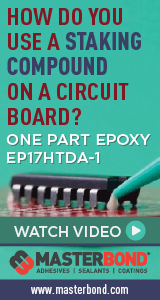|

|
|
| Ask the Experts | |||||||
|
|||||||
|
July 17, 2013 - Updated July 9, 2013 - Originally Posted Step Stencil QuestionsWhen shifting from standard solder paste stencils to step stencils, should we change the pressure or attack angle? M.K. |
|||||||
| Expert Panel Responses | |||||||
|
Pressureis set to achieve clean wipe of solder paste as in normal SMT printing. However there will be some excess paste left around the step area. Normally, you should not have to change squeegee blade angle unless you aretrying to achieve hole fill in through hole area. In this case it isrecommended to change angle to 45 degrees to get better barrel through holefill with solder paste.
Vice President Technology Photo Stencil For over 18 years, Dr. Coleman has been the vice president of technology for Photo Stencil, working closely with customers to understand their printing requirements. His efforts have resulted in several new stencil products.
Youmay find that you need a small increase in pressure. Whether you do or notdepends on the design of the step, the depth (height) of the step. A change inpressure implies a change in the effective angle of attack; more pressure,lower angle of attack. The change depends on the squeegee system in use. Stepstencils can sometimes be avoided by designing the board to be over-printedwhere more volume is needed. This is a solution only where extra volume isneeded in limited areas, and performance may be somewhat sensitive to thesolder mask used. Stepstencils can be attractive but they have their own set of issues. For instanceconsider a stencil with stepped-down areas for printing finer pitch devices.The stepped-down areas will often have a surface finish that is not as smoothas the rest of the stencil. If the stepped-down area is on the top (squeegee)side of the stencil, paste particles will tend to hang in the surfaceroughness, and the squeegee will glide over the top, leaving a single layer ofpaste particles, and effectively making that area of the stencil thicker. Forthis reason I recommend putting step-downs on the bottom side, and allowing 10times the step height between the step and any printed features. Thinstencils with stepped-up areas for printing devices with higher solder demandrepresent another challenge. The bulk of the stencil will have been thinned. Ifthe process used to thin the stencil is not uniform, then paste volume may varyacross the board. The changes in surface finish also apply, and so it is bestto have the stepped side on the bottom. Note that some stencil fabricators may use electroforming to manufacturesteps, which may mitigate some or all of the surface finish differences, andpotentially the hard step. Whether this technology is appropriate for a give applicationis another question. Finally, when differences in solder requirements are toolarge for a step stencil to accommodate, a double-print strategy can be used,with the second stencil relieved in the areas printed with the first.
Process Engineer Astronautics Fritz's career in electronics manufacturing has included diverse engineering roles including PWB fabrication, thick film print & fire, SMT and wave/selective solder process engineering, and electronics materials development and marketing. Fritz's educational background is in mechanical engineering with an emphasis on materials science. Design of Experiments (DoE) techniques have been an area of independent study. Fritz has published over a dozen papers at various industry conferences.
|
|||||||
| Submit A Comment | |||||||
|
Comments are reviewed prior to posting. You must include your full name to have your comments posted. We will not post your email address. |
|
Free Newsletter Subscription
Circuitnet is built for professionals who bear the responsibility of looking ahead, imagining the future, and preparing for it. Insert Your Email Address |
|

|




